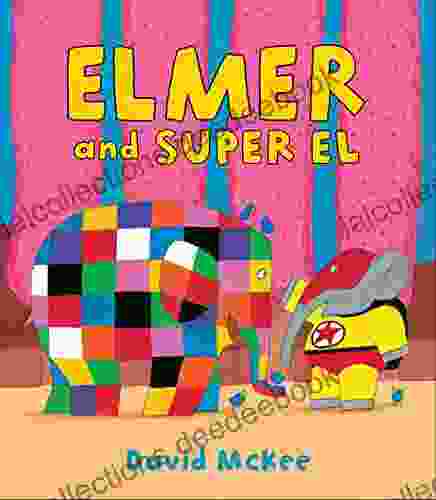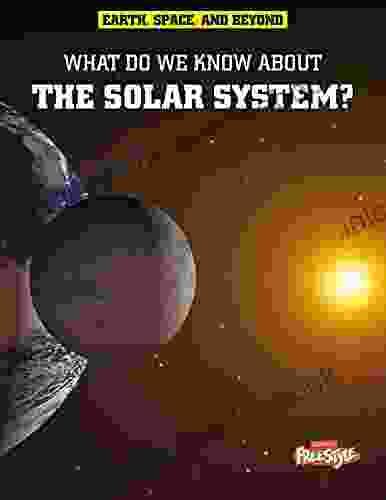What Do We Know About The Solar System: Earth, Space, and Beyond

Our solar system is a vast and fascinating place, full of wonders that have captured the imagination of humans for centuries. From the familiar planets of our own neighborhood to the distant reaches of the outer solar system, there is much to explore and learn.
In this article, we will take a journey through our solar system, exploring the planets, moons, asteroids, comets, and other objects that make up this cosmic neighborhood. We will learn about their unique characteristics, their place in the solar system, and the mysteries that still surround them.
4.2 out of 5
| Language | : | English |
| Text-to-Speech | : | Enabled |
| Enhanced typesetting | : | Enabled |
| Word Wise | : | Enabled |
| File size | : | 23671 KB |
| Screen Reader | : | Supported |
| Print length | : | 48 pages |
The Sun
The sun is the center of our solar system and the source of all its energy. It is a massive ball of hot plasma, with a surface temperature of about 9,940 degrees Fahrenheit (5,505 degrees Celsius). The sun's energy is produced by nuclear fusion reactions in its core, where hydrogen atoms are combined to form helium atoms.
The sun's gravity holds the solar system together, keeping the planets, moons, and other objects in orbit around it. The sun also emits a constant stream of charged particles called the solar wind, which can affect the Earth's magnetic field and cause auroras.
The Planets
There are eight planets in our solar system: Mercury, Venus, Earth, Mars, Jupiter, Saturn, Uranus, and Neptune. Each planet is unique, with its own size, mass, composition, and atmosphere.
- Mercury is the closest planet to the sun and the smallest planet in the solar system. It is a rocky planet with a thin atmosphere and a heavily cratered surface.
- Venus is the second closest planet to the sun and is often called Earth's twin because of its similar size and mass. However, Venus has a much thicker atmosphere than Earth, which traps heat and makes the planet very hot.
- Earth is the third closest planet to the sun and the only planet in the solar system known to support life. Earth has a thick atmosphere, liquid water on its surface, and a variety of climates.
- Mars is the fourth closest planet to the sun and is often called the Red Planet because of its reddish appearance. Mars has a thin atmosphere, a rocky surface, and two small moons.
- Jupiter is the fifth closest planet to the sun and the largest planet in the solar system. Jupiter is a gas giant, composed mostly of hydrogen and helium. It has a thick atmosphere, a Great Red Spot that is a giant storm, and a large number of moons.
- Saturn is the sixth closest planet to the sun and the second largest planet in the solar system. Saturn is also a gas giant, composed mostly of hydrogen and helium. It has a thick atmosphere, a prominent ring system, and a large number of moons.
- Uranus is the seventh closest planet to the sun and the third largest planet in the solar system. Uranus is an ice giant, composed mostly of hydrogen, helium, and ice. It has a thick atmosphere, a ring system, and a large number of moons.
- Neptune is the eighth closest planet to the sun and the fourth largest planet in the solar system. Neptune is also an ice giant, composed mostly of hydrogen, helium, and ice. It has a thick atmosphere, a ring system, and a large number of moons.
The Moons
In addition to the eight planets, our solar system also contains a large number of moons. Moons are natural satellites that orbit planets. There are over 200 known moons in our solar system, ranging in size from tiny moonlets to large moons that are larger than some planets.
Some of the most famous moons in our solar system include:
- The Moon, which orbits Earth, is the only celestial body that humans have visited.
- Europa, which orbits Jupiter, is a moon that is thought to have a subsurface ocean that could potentially harbor life.
- Ganymede, which also orbits Jupiter, is the largest moon in the solar system and is larger than the planet Mercury.
- Titan, which orbits Saturn, is a moon that has a thick atmosphere and methane lakes on its surface.
The Asteroids
Asteroids are small, rocky objects that orbit the sun. They are typically found in the asteroid belt, which is a region of space between the orbits of Mars and Jupiter. There are millions of asteroids in the asteroid belt, ranging in size from small pebbles to large asteroids that are hundreds of kilometers across.
Some asteroids are thought to be fragments of planets that were destroyed in collisions long ago. Others may be comets that have lost their volatile materials.
The Comets
Comets are icy objects that orbit the sun. They are composed of a nucleus of ice and dust, and they have a long, flowing tail that is made up of gas and dust that is released as the comet approaches the sun.
Comets are thought to be leftovers from the formation of the solar system. They are often found in the outer solar system, but they can occasionally come close to the sun.
The Kuiper Belt and the Oort Cloud
The Kuiper Belt is a region of space beyond the orbit of Neptune. It is home to a large number of icy objects, including comets and dwarf planets. The most famous object in the Kuiper Belt is Pluto, which was demoted from planet status in 2006.
The Oort Cloud is a hypothetical region of space that is thought to surround the solar system. It is thought to be home to a large number of icy objects, including comets. The Oort Cloud is so far away that it has not yet been directly observed.
The Future of Solar System Exploration
The exploration of our solar system is an ongoing process. Scientists are constantly learning more about the planets, moons, asteroids, comets, and other objects that make up this cosmic neighborhood.
4.2 out of 5
| Language | : | English |
| Text-to-Speech | : | Enabled |
| Enhanced typesetting | : | Enabled |
| Word Wise | : | Enabled |
| File size | : | 23671 KB |
| Screen Reader | : | Supported |
| Print length | : | 48 pages |
Do you want to contribute by writing guest posts on this blog?
Please contact us and send us a resume of previous articles that you have written.
 Book
Book Novel
Novel Chapter
Chapter Story
Story Genre
Genre Reader
Reader Paperback
Paperback E-book
E-book Newspaper
Newspaper Sentence
Sentence Shelf
Shelf Glossary
Glossary Foreword
Foreword Preface
Preface Synopsis
Synopsis Footnote
Footnote Tome
Tome Classics
Classics Autobiography
Autobiography Memoir
Memoir Encyclopedia
Encyclopedia Narrator
Narrator Resolution
Resolution Catalog
Catalog Archives
Archives Periodicals
Periodicals Study
Study Scholarly
Scholarly Academic
Academic Journals
Journals Reading Room
Reading Room Rare Books
Rare Books Special Collections
Special Collections Interlibrary
Interlibrary Literacy
Literacy Thesis
Thesis Dissertation
Dissertation Reading List
Reading List Theory
Theory Textbooks
Textbooks Peggy House
Peggy House Clay Mcleod Chapman
Clay Mcleod Chapman Aaron Heinrich
Aaron Heinrich John L Dornhoffer
John L Dornhoffer E R Johnson
E R Johnson Beatrice Edwards
Beatrice Edwards Nick James
Nick James Marc Cranswick
Marc Cranswick Jamie Davis
Jamie Davis Daniel R Levitt
Daniel R Levitt Emily Ifsits
Emily Ifsits Shristuti Srirapu
Shristuti Srirapu Duncan Maclaughlin
Duncan Maclaughlin Eat Like A Local
Eat Like A Local Aaron Cohen
Aaron Cohen Nita Tewari
Nita Tewari Rick Partlow
Rick Partlow Paul Allain
Paul Allain Veronica G Henry
Veronica G Henry Charlotte Eriksson
Charlotte Eriksson
Light bulbAdvertise smarter! Our strategic ad space ensures maximum exposure. Reserve your spot today!

 Isaias BlairThe Adventures of Elmer and Super El: A Literary Exploration of Imagination...
Isaias BlairThe Adventures of Elmer and Super El: A Literary Exploration of Imagination... Eugene ScottFollow ·12.8k
Eugene ScottFollow ·12.8k Ernest ClineFollow ·13.3k
Ernest ClineFollow ·13.3k Arthur MasonFollow ·14.9k
Arthur MasonFollow ·14.9k Pablo NerudaFollow ·19k
Pablo NerudaFollow ·19k Richard SimmonsFollow ·4.4k
Richard SimmonsFollow ·4.4k Herbert CoxFollow ·5.6k
Herbert CoxFollow ·5.6k George HayesFollow ·17.3k
George HayesFollow ·17.3k Jamal BlairFollow ·10k
Jamal BlairFollow ·10k

 Andy Hayes
Andy HayesEmbracing Now: Embark on a Mindfulness Journey for a...
In a world...

 Heath Powell
Heath Powell100 Hymns for Violin and Guitar: A Comprehensive Guide to...
The violin and...

 Floyd Richardson
Floyd RichardsonBark In The Park: Poems For Dog Lovers
Dogs are our best...

 Douglas Adams
Douglas AdamsThe Barter Crusade: A Journey into the Realm of Exchange...
In a world driven by monetary transactions,...

 Nathaniel Hawthorne
Nathaniel HawthorneInsight Guides Explore Nice & the French Riviera...
Prepare to embark on an unforgettable journey...

 Carlos Fuentes
Carlos FuentesThe Ultimate Practical Guide to Percussion: Exploring the...
Embark on a journey into the enchanting...
4.2 out of 5
| Language | : | English |
| Text-to-Speech | : | Enabled |
| Enhanced typesetting | : | Enabled |
| Word Wise | : | Enabled |
| File size | : | 23671 KB |
| Screen Reader | : | Supported |
| Print length | : | 48 pages |










